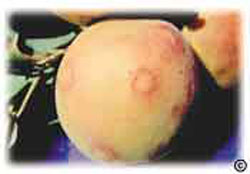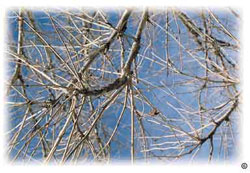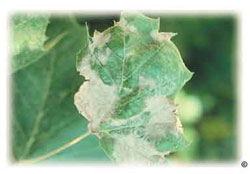Sycamore anthracnose is the most serious disease of sycamore trees. The fungus attacks  newly emerging leaves early in the spring, which causes rapid wilting. Thebrown, irregular leaf spots on older leaves may be confused with frost damage. Smaller spots tend to follow the edges of veins, but they may enlarge to encompass the whole leaf. Sycamore leaves are naturally fuzzy, so be careful not to confuse this natural feature with the fungus.
newly emerging leaves early in the spring, which causes rapid wilting. Thebrown, irregular leaf spots on older leaves may be confused with frost damage. Smaller spots tend to follow the edges of veins, but they may enlarge to encompass the whole leaf. Sycamore leaves are naturally fuzzy, so be careful not to confuse this natural feature with the fungus.
Anthracnose is especially damaging because it attacks leaves and woody tissue. Cankers, or sunken diseased areas, form on woody tissue. These dead, rough areas typically are darker in color than the surrounding tissue. Cankers may kill the ends of twigs back eight to ten inches from the tip.
or sunken diseased areas, form on woody tissue. These dead, rough areas typically are darker in color than the surrounding tissue. Cankers may kill the ends of twigs back eight to ten inches from the tip.
Cankers are active in the spring when they enlarge and produce spores that further spread the disease. Look closely for black flecks the size of pepper granules-these are the fruiting bodies of the fungus.
Anthracnose is especially active when the weather is cool and wet. In the spring, monitor the temperature during the two-week period following emergence of the first leaves. If the average temperature is below 55 degrees Fahrenheit, the shoot-blight phase of the disease will be serious. Little or no anthracnose will occur if average temperatures during this susceptible leaf expansion stage are above 60 degrees Fahrenheit.
the temperature during the two-week period following emergence of the first leaves. If the average temperature is below 55 degrees Fahrenheit, the shoot-blight phase of the disease will be serious. Little or no anthracnose will occur if average temperatures during this susceptible leaf expansion stage are above 60 degrees Fahrenheit.
A chemical control option would be to use copper fungicides. Apply fungicides when buds on the tree begin to swell. When spring rains occur frequently, you’ll need to apply the fungicide two more times -once at bud break, the other ten to 14 days later. Registered products include chlorothalanil, thiophanate- methyl and copper.
Be sure to prune and destroy all infected twigs and branches, remove and destroy all fallen leaves, and completely remove cankered areas. If not removed, they will produce infectious spores the following spring.
For more information, see the following Colorado State University Extension fact sheet(s).



